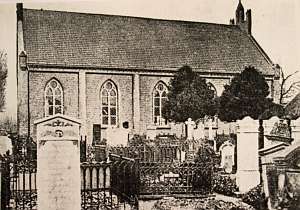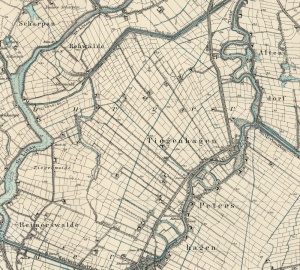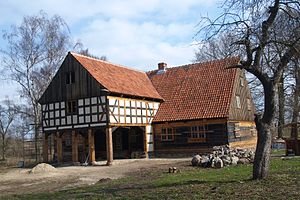Difference between revisions of "Tiegenhagen (Pomeranian Voivodeship, Poland)"
| [checked revision] | [checked revision] |
m |
m (Text replace - "<em>Mennonitisches Lexikon</em>, 4 vols. Frankfurt & Weierhof: Hege; Karlsruhe: Schneider, 1913-1967: v. IV," to "''Mennonitisches Lexikon'', 4 vols. Frankfurt & Weierhof: Hege; Karlsruhe: Schneider, 1913-1967: v. IV,") |
||
| Line 30: | Line 30: | ||
"Geschichte der Kirche." St. Nikolaus Pfarrei aus Cyganek. Web. 5 November 2012. [http://www.cyganek.ndg.pl/indexDE.php http://www.cyganek.ndg.pl/indexDE.php?go=hist_kosc]. | "Geschichte der Kirche." St. Nikolaus Pfarrei aus Cyganek. Web. 5 November 2012. [http://www.cyganek.ndg.pl/indexDE.php http://www.cyganek.ndg.pl/indexDE.php?go=hist_kosc]. | ||
| − | Hege, Christian and Christian Neff. | + | Hege, Christian and Christian Neff. ''Mennonitisches Lexikon'', 4 vols. Frankfurt & Weierhof: Hege; Karlsruhe: Schneider, 1913-1967: v. IV, 329. |
Penner, Horst. Ansiedlung menn. <em>Niederländer im Weichselmündungsgebiet von der Mitte des 16. Jh. bis zum Beginn der preussischen Zeit</em>. Weierhof, 1940. | Penner, Horst. Ansiedlung menn. <em>Niederländer im Weichselmündungsgebiet von der Mitte des 16. Jh. bis zum Beginn der preussischen Zeit</em>. Weierhof, 1940. | ||
Revision as of 07:00, 16 January 2017

Source: Catalogue of Monuments of Dutch Colonization in Poland website
Tiegenhagen (also known as Thuenhain; now known as Tujce Cyganek, Tujec, and Żelichowo-Cyganek; coordinates: 54.241506, 19.141788 [54° 14′ 29″ N, 19° 08′ 30″ E]), is located on the left bank of the river Tuga (Tiege) across from Żelichowo (Petershagen), located approximately 3 kilometers (2 miles) north-east of Nowy Dwór Gdański (Tiegenhof), 18 km (11 miles) north-west of Elbląg (Elbing), and 24 km (15 miles) north-east of Malbork (Marienburg). It is a village in the northern part of the lowlands of the Vistula Delta, below sea level, protected from the sea by dikes.
Tiegenhagen was most likely founded in the 1330s and was granted the Chełmno Rights (Kulm Law, a legal constitution for a municipal form of government) on 12 August 1352 by Winrich von Kniprode, Grand Master of the Teutonic Knights. The village had a total of 60 włókas (1,077,3 hectares [ha]). The church parish was established at the same time. A section of the St. Nicolas Church was probably erected as early as the 14th century. When the rule of the Teutonic Knights decayed, the village was overtaken by marsh and alders. Not until 1550 were attempts made to resettle the area. Over the years, the inhabitants of Tiegenhagen gradually raised the elevation of many areas and permanently reclaimed land that was once prone to annual flooding.
Until 1772 Tiegenhagen was part of the Kingdom of Poland. The First Partition of Poland in 1772 resulted in the creation of a new province in 1773, called West Prussia, in which Tiegenhagen was located. Tiegenhagen was situated in the district (Kreis) of Marienburg until the establishment of the Free City of Danzig in 1920. The village came under the control of Nazi Germany during World War II until February 1945, when it was occupied by Soviet forces and returned to Poland.
By 1640 Tiegenhagen was the Mennonite center of the Tiegenhof Lowlands, where the Mennonites owned over 200 hides of land. Tiegenhagen was also the seat of the Mennonite mutual fire insurance, which was founded in 1623 and covered all the farms and other buildings owned by Mennonites in the Grosswerder. About 1620 Claass Kreker possessed the three "Freihufen" of the village, which his descendants still held in 1750.
The Tiegenhagen Mennonite church belonged to the Flemish branch; until 1639 it was served by the elder of Danzig, but then chose Hans Siemens as its elder and thus became an independent congregation. As this Grosswerder congregation continued to grow, it was decided in 1735 to establish four quarters: Elbing Quarter (Rosenort congregation), Tiegenhagen Quarter, Orloff Quarter (Ladekopp congregation), and Bärwalde Quarter (Fürstenwerder congregation). All four quarters were to have a single elder, but each was to have its own preachers. Gradually the daughter congregations of the Grosswerder congregation became independent and in the first half of the 19th century chose their own elders, Fürstenwerder being the first to do so in 1809. In 1814 Abraham Wiebe of Tiegenhagen was chosen as elder of the other three quarters. When Wiebe died in 1833, the Tiegenhagen congregation became independent and chose Peter Regier of Tiegenhagen as its elder. The Ladekopp congregation thereupon chose Jacob Wiebe in the same year, while Rosenort continued to be served by the elder of Tiegenhagen. Finally in 1857 Rosenort chose Nicolaus Fast as its elder.
A special grant by the Bishop of Culm permitted the Mennonites of Tiegenhagen to build a frame church "40 ells long, 22 ells wide, 7 ells high along the walls, with ordinary doors and windows, thatch roof, a chimney extending above the church and an apartment for residence in it" (Driedger). Until 1892 this frame church was in use. In that year the old church was torn down and a new brick church erected on the same site on the bank of the Tiege. The congregation was incorporated in 1882. Between the two World Wars a monthly meeting was held in the northern part of the congregational area in Steegen in the home of Jacob Hamm. The congregation was served by an elder, five preachers, and two deacons. The membership remained rather constant throughout the last century. In 1852 the congregation numbered 591 baptized members. In 1858 there were 754 Mennonites including children, who owned 168 hides of land. In 1887 the baptized membership was 433, with 229 children. In 1940 there were some 800 Mennonites who belonged to the Tiegenhagen congregation and lived in the north of the Grosswerder area and in the Danzig Lowlands.
The Prussian census of 1776 lists 64 Mennonite families in Tiegenhagen with the following surnames: Allert, Baldt, Bargmann, Bark, Bru(h)n, Claas(s)en, Dick, Dirksen, Ens, Epp, Fast, Fresch, Friese, Friesen, Froese, Gerbrand, Gossen, Isaac, Kettler, Kroecker, Laemmert, Loewen, Mantler, Mecklenburger, Neufeldt, Nickel, Pauls, Penck, Penner, Quiring, Reimer, Rempel, Siemens, Suckau, Toews, Vogt, Waelck, Warkentin, and Wieb. In 1820 there were 549 inhabitants in Tiegenhagen/Pisskrug with 256 Mennonites. In 1885, the area of the village equaled 1074 ha; the village had 78 houses, 671 Catholics and Lutherans, and 198 Mennonites.
The Flemish Mennonites of Tiegenhagen were members of the Tiegenhagen Mennonite Church while the minority Frisian Mennonites were members of the Orlofferfelde Mennonite Church.
Bibliography
Driedger, Abraham. "Aus der Geschichte der Mennonitengemeinde Heubuden." Mennonitische Blätter (1939): 42.
"Geschichte der Kirche." St. Nikolaus Pfarrei aus Cyganek. Web. 5 November 2012. http://www.cyganek.ndg.pl/indexDE.php?go=hist_kosc.
Hege, Christian and Christian Neff. Mennonitisches Lexikon, 4 vols. Frankfurt & Weierhof: Hege; Karlsruhe: Schneider, 1913-1967: v. IV, 329.
Penner, Horst. Ansiedlung menn. Niederländer im Weichselmündungsgebiet von der Mitte des 16. Jh. bis zum Beginn der preussischen Zeit. Weierhof, 1940.
Penner, Horst. Die ost- und westpreussischen Mennoniten in ihrem religiösen und sozialen Leben in ihren kulturellen und wirtschaftlichen Leistungen, 2 vols. Weierhof, Germany: Mennonitischer Geschichtsverein, 1978-1987: 250.
Regehr, Ernst. "Zur 300-Jahrfeier der Gemeinde Rosenort." Mennonitische Blätter (1939): 61 ff.
Reimer, Gustav. "Ein aufgefundenes Kirchenbuch." Mennonitische Blätter (1939): 22 ff.
Stowarzyszenie Konserwatorów Zabytków. "Cyganek (Tujce Cyganek, Tujec, Żelichowo - Cyganek)." Catalogue of Monuments of Dutch Colonization in Poland. 2005. Web. 13 September 2014. http://holland.org.pl/art.php?kat=obiekt&id=306.
Additional Information
Elders of the Grosses Werder Mennonite Church
| Elder | Years of Service |
|---|---|
| Hans Siemens (d. 1644) | 22 Sep 1639-Feb 1644 |
| Peter Claassen | 31 Oct 1645–8 Oct 1679 |
| Harm Neufeld (d. 1695) | 1676-1695 |
| Dirk Siemens (d. 1729), Tiegenhagen | 6 Sep 1695–24 Nov 1729 |
| Abraham Buhler, Co-Elder | Until 1726 |
| Simon von Riesen (d. 1736), Klein Mausdorf | 18 Sep 1729–fall 1736 |
| Cornelius Andres (1680-1741), Tiegerweide | 7 Jun 1736–11 Jun 1741 |
| Hans Buhler, Klein Mausddorferfeld | 10 Sep 1741–29 Sep 1754 |
| Abraham Penner (d. 1766), Rueckenauerfeld | 2 Feb 1755–28 Nov 1766 |
| Dirk Thiessen (1727-1806), Petershagen | 1 Feb 1767–11 Jun 1806 |
| Cornelius Warkentin (1740-1809), Rosenort | 13 Sep 1795–10 Jan 1809 |
| Peter Regier (1776-1814), Siebenhuben | 12 Jul 1808–26 Feb 1814 |
| Abraham Wiebe (1764-1833), Tiegenhagen | 4 May 1814–12 Feb 1833 |
| Peter Regier (1798-1856), Tiegenhagen | 14 Feb 1835–9 Mar 1856 |
Elders of the Tiegenhagen Mennonite Church
| Elder | Years of Service |
|---|---|
| Abraham Esau (1799-1885) | 19 Oct 1856–12 Apr 1885 |
| Abraham Regier (1831-1908) | 1885–14 Oct 1908 |
| Abraham Wieler (1857-1916) | 8 Aug 1909–27 Jul 1916 |
| Franz Regehr (1871-1945) | 1919-1945 |
Maps
Map:Tujce, Pomeranian Voivodeship, Poland
| Author(s) | Horst Penner |
|---|---|
| Richard D. Thiessen | |
| Date Published | April 2013 |
Cite This Article
MLA style
Penner, Horst and Richard D. Thiessen. "Tiegenhagen (Pomeranian Voivodeship, Poland)." Global Anabaptist Mennonite Encyclopedia Online. April 2013. Web. 21 Nov 2024. https://gameo.org/index.php?title=Tiegenhagen_(Pomeranian_Voivodeship,_Poland)&oldid=146293.
APA style
Penner, Horst and Richard D. Thiessen. (April 2013). Tiegenhagen (Pomeranian Voivodeship, Poland). Global Anabaptist Mennonite Encyclopedia Online. Retrieved 21 November 2024, from https://gameo.org/index.php?title=Tiegenhagen_(Pomeranian_Voivodeship,_Poland)&oldid=146293.
Adapted by permission of Herald Press, Harrisonburg, Virginia, from Mennonite Encyclopedia, Vol. 4, pp. 721-722. All rights reserved.
©1996-2024 by the Global Anabaptist Mennonite Encyclopedia Online. All rights reserved.



